
Note: This document is for an older version of GRASS GIS that will be discontinued soon. You should upgrade, and read the current manual page.
NAME
r.accumulate - Calculates weighted flow accumulation, subwatersheds, stream networks, and longest flow paths using a flow direction map.KEYWORDS
raster, hydrology, accumulation, watershed, subwatershed, stream network, longest flow pathSYNOPSIS
Flags:
- -n
- Use negative flow accumulation for likely underestimates
- -0
- Use 0s instead of nulls for no flow accumulation (faster)
- -a
- Calculate accumulated longest flow paths
- -c
- Delineate streams across confluences
- -r
- Use recursive algorithms
- --overwrite
- Allow output files to overwrite existing files
- --help
- Print usage summary
- --verbose
- Verbose module output
- --quiet
- Quiet module output
- --ui
- Force launching GUI dialog
Parameters:
- direction=name [required]
- Name of input direction map
- format=string [required]
- Format of input direction map
- Options: auto, degree, 45degree
- Default: auto
- auto: auto-detect direction format
- degree: degrees CCW from East
- 45degree: degrees CCW from East divided by 45 (e.g. r.watershed directions)
- weight=name
- Name of input flow weight map
- input_accumulation=name
- Name of input weighted flow accumulation map
- input_subaccumulation=name
- Name of input flow subaccumulation map
- accumulation=name
- Name for output weighted flow accumulation map
- subaccumulation=name
- Name for output weighted flow subaccumulation map
- accumulation_type=string
- Type of raster map to be created
- Type of accumulation raster map to be created
- Options: CELL, FCELL, DCELL
- Default: CELL
- CELL: Integer
- FCELL: Single precision floating point
- DCELL: Double precision floating point
- subwatershed=name
- Name for output subwatershed map
- stream=name
- Name for output stream vector map
- threshold=float
- Minimum flow accumulation for streams
- coordinates=east,north[,east,north,...]
- Coordinates of longest flow path outlet point
- id=integer[,integer,...]
- ID for longest flow path
- outlet=name
- Name of input outlet vector map for longest flow path
- Or data source for direct OGR access
- outlet_layer=string
- Layer number or name for outlet points
- Vector features can have category values in different layers. This number determines which layer to use. When used with direct OGR access this is the layer name.
- Default: 1
- outlet_id_column=name
- Name of longest flow path ID column in outlet vector map
- id_column=name
- Name for output longest flow path ID column
- longest_flow_path=name
- Name for output longest flow path vector map
Table of contents
DESCRIPTION
r.accumulate calculates weighted flow accumulation, subwatersheds, stream networks, and longest flow paths (Cho 2020) using a flow direction map.NOTES
Flow accumulation
Unlike r.watershed, r.accumulate does not require elevation data to calculate weighted flow accumulation. Instead, this module only uses a flow direction map to trace and accumulate the amount of flow draining through and including each cell.With -n flag, the module will count the number of upstream cells plus one and convert it to the negative if any upstream cells are likely to receive flow from outside the computational region (flow direction edges). Negative values identify cells with likely underestimates because not all upstream cells were accounted for. Since raster map weight may contain negative flow weights, -n flag is not compatible with weight option. Running the module twice with and without -n flag and weight option may be useful in this specific case.
The module recognizes two different formats of the flow direction map:

Since the module does not use elevation data (i.e., slope), flow accumulation is calculated by single flow direction (SFD) routing and may not be comparable to the result from multiple flow direction (MFD) routing.
The module requires flow accumulation for any output, so it will internally accumulate flows every time it runs unless input_accumulation option is provided to save computational time by not repeating this process. In this case, it is important to use flow accumulation consistent with the flow direction map (e.g., accumulation output from this module).
Subwatershed delineation
With subwatershed option, the module will delineate subwatersheds for outlets specified by coordinates and/or outlet options.Stream network delineation
With stream and threshold options, the module will delineate stream networks with the minimum flow accumulation for stream generation. A weight input map may be used with threshold. Delineated stream lines are split at confluences.With -c flag, stream lines are delineated across confluences and may overlap with other stream lines that share the same downstream outlet.
With input_subaccumulation option, streams will be delineated as if there are no incoming flows from upstream subwatersheds defined by subaccumulation. This option is useful when you want to delineate streams completely contained inside a subwatershed without considering the main channel coming from outside the subwatershed (e.g., surface runoff within subwatersheds).
Longest flow path calculation
With longest_flow_path option, the module will create a longest flow path vector map for outlet points specified by coordinates and/or outlet with outlet_layer option, using the algorithm by Cho (2020). By default, longest flow paths will be created as if there were subwatersheds at the outlets by calculating the subaccumulation map. Downstream longest flow paths will never traverse through upstream outlets. With -a flag, longest flow paths will be created in an accumulated manner resulting in an overlap between downstream and upstream longest flow paths.You can assign unique IDs to longest flow paths using id (with coordinates) and/or outlet_id_column (with outlet). Assigning IDs also requires id_column option to specify the output column name for the IDs in the longest_flow_path vector map. The outlet_id_column specifies a column in the outlet vector map that contains unique IDs to be copied over to the id_column column in the output map. This column must be of integer type.
EXAMPLES
These examples use the North Carolina sample dataset.Flow accumulation
Calculate flow accumulation using r.watershed and r.accumulate:
# set computational region g.region -p raster=elevation # calculate positive flow accumulation and drainage directions using r.watershed # for comparison, use -s (SFD) r.watershed -sa elevation=elevation accumulation=flow_accum drainage=drain_directions # calculate flow accumulation using r.accumulate r.accumulate direction=drain_directions accumulation=flow_accum_new # copy color table r.colors map=flow_accum_new raster=flow_accum # check difference between flow_accum and flow_accum_new r.mapcalc expression="flow_accum_diff=if(flow_accum-flow_accum_new, flow_accum-flow_accum_new, null())"
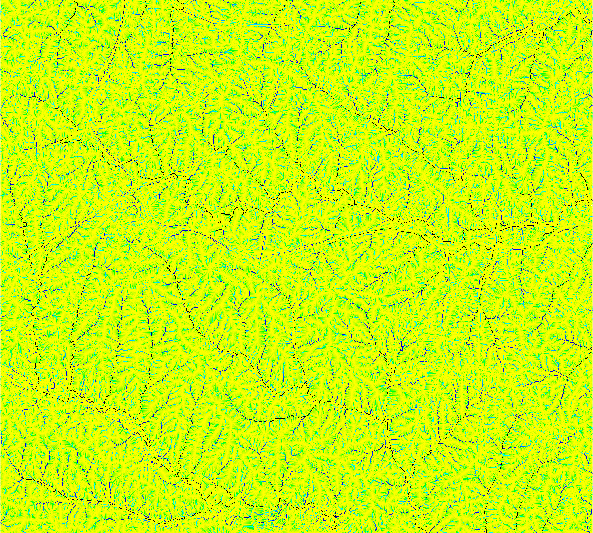
There are slight differences between the two output maps. The yellow and purple cells show the difference raster map (flow_accum_diff). The red arrows and numbers represent drainage directions (drain_directions) and flow accumulation by r.watershed (flow_accum), respectively. Note that some cells close to headwater cells are assigned 1 even though they are located downstream of other cells.
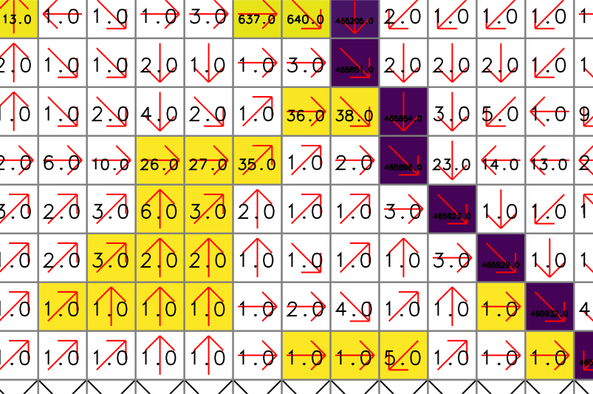
For comparison, these numbers show the new flow accumulation by r.accumulate (flow_accum_new). The same cells are properly accumulated from the headwater cells.
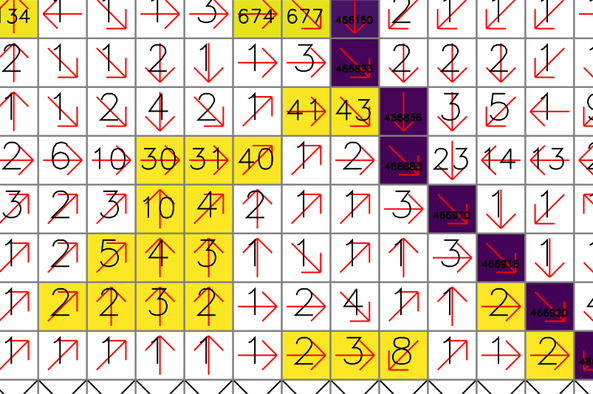
Stream network delineation
Calculate flow accumulation and delineate stream networks at once:
# set computational region
g.region -p raster=elevation
# calculate positive flow accumulation and drainage directions using r.watershed
# for comparison, use -s (SFD)
r.watershed -sa elevation=elevation accumulation=flow_accum drainage=drain_directions
# use r.accumulate to create flow_accum_new and streams_new at once
r.accumulate direction=drain_directions accumulation=flow_accum_new threshold=50000 \
stream=streams_new
# or delineate stream networks only without creating an accumulation map
r.accumulate direction=drain_directions threshold=50000 stream=streams_new_only
# use r.stream.extract, elevation, and flow_accum to delineate stream networks
r.stream.extract elevation=elevation accumulation=flow_accum threshold=50000 \
stream_vector=streams_extract direction=drain_directions_extract
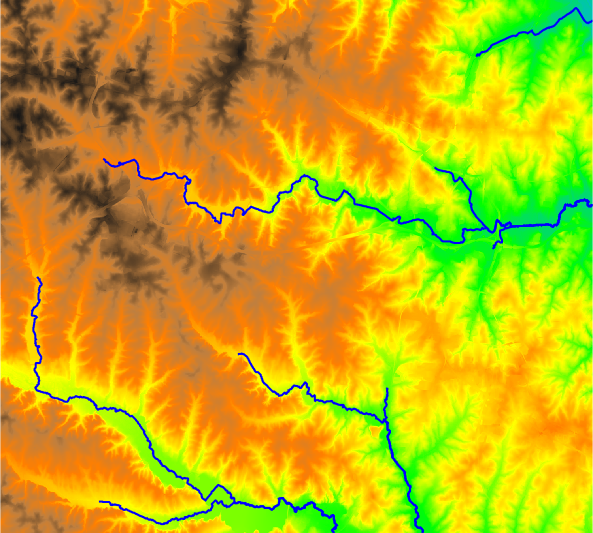
In this example, r.accumulate and r.stream.extract produced slightly different stream networks where the flow turns 90 degrees or there are multiple downstream cells with the same elevation. The following figure shows an example where the streams (red from r.stream.extract) and streams_new (blue from r.accumulate) vector maps present different stream paths. The numbers show cell elevations (elevation map), and the yellow (drain_directions map) and green (drain_directions_extract map) arrows represent flow directions generated by r.watershed with -s flag and r.stream.extract, respectively. Note that the two flow direction maps are different.

Subwatershed delineation
Delineate the watershed for one outlet:
# set computational region g.region -p raster=elevation # calculate drainage directions using r.watershed r.watershed -s elevation=elevation drainage=drain_directions # delineate the watershed for one outlet r.accumulate direction=drain_directions subwatershed=watershed lfp=lfp coordinates=642455,222614
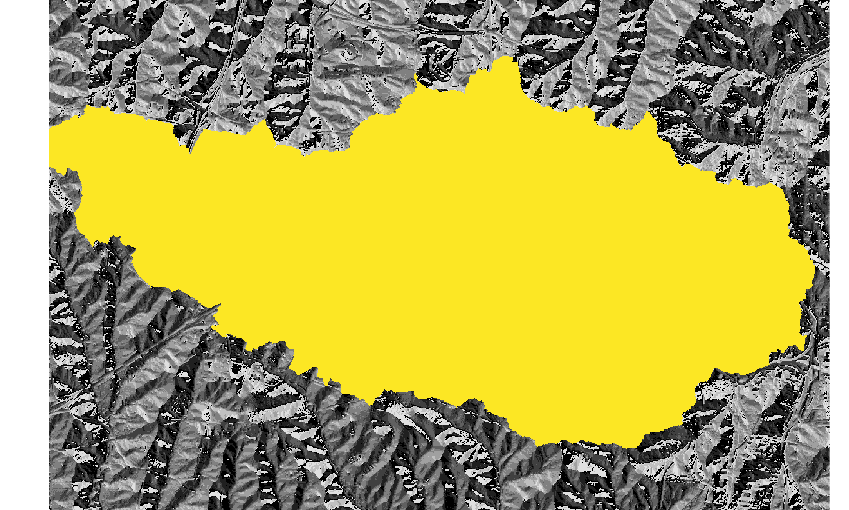
Delineate multiple subwatersheds:
# set computational region
g.region -p raster=elevation
# calculate drainage directions using r.watershed
r.watershed -s elevation=elevation drainage=drain_directions
# delineate two subwatersheds
r.accumulate direction=drain_directions subwatershed=subwatersheds \
coordinates=642455,222614,637176,223625
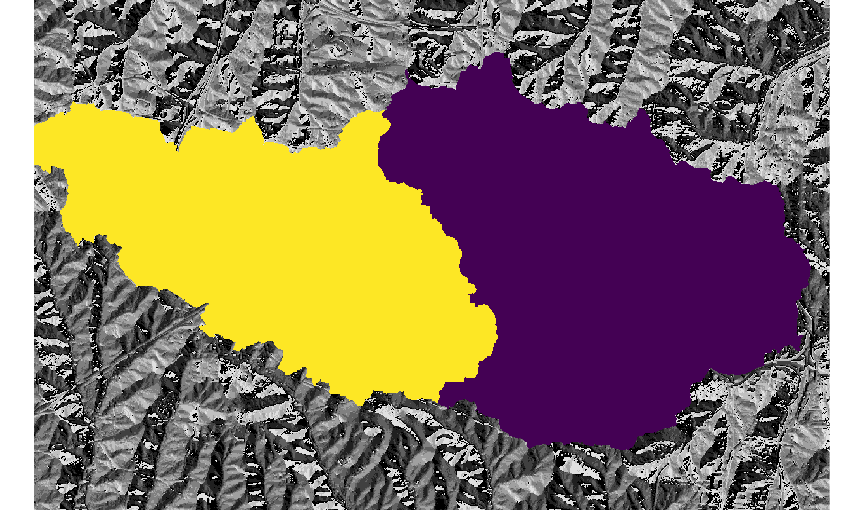
Longest flow path calculation
Calculate the longest flow path for one outlet:
# set computational region g.region -p raster=elevation # calculate drainage directions using r.watershed r.watershed -s elevation=elevation drainage=drain_directions # calculate the longest flow path and delineate the watershed for an outlet r.accumulate direction=drain_directions subwatershed=watershed lfp=lfp coordinates=642455,222614
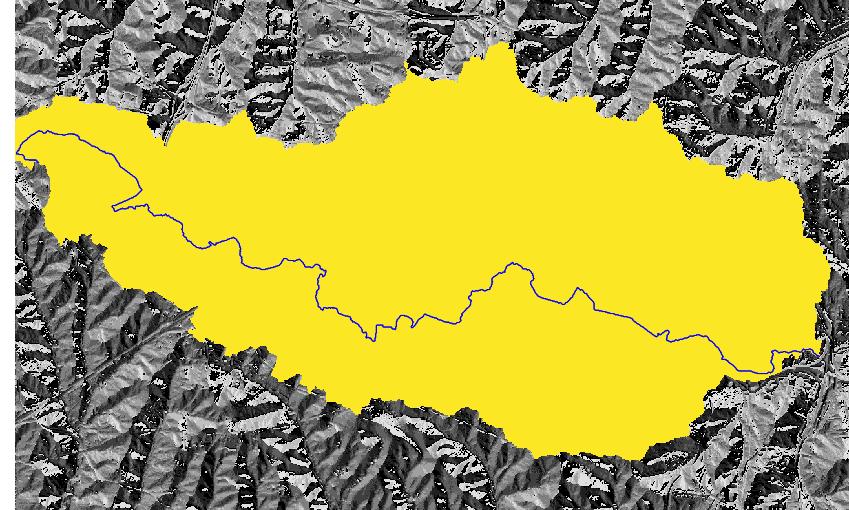
Note that there can be more than one longest flow path when multiple paths have the same flow length. In fact, the above example produces two lines with the same length.
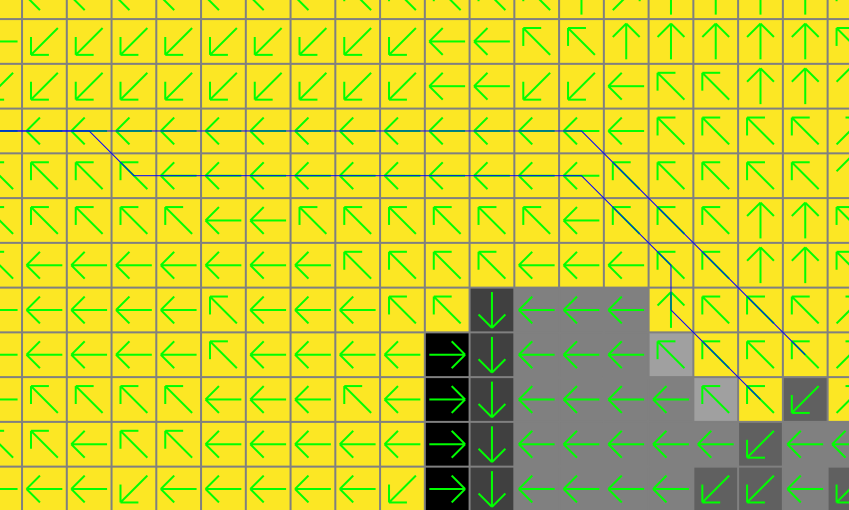
There are different ways to calculate multiple longest flow paths in one run:
# set computational region
g.region -p raster=elevation
# calculate drainage directions using r.watershed
r.watershed -s elevation=elevation drainage=drain_directions
# calculate longest flow paths at two outlets
r.accumulate direction=drain_directions lfp=lfp coordinates=642455,222614,642314,222734
# calculate longest flow paths at two outlets and assign IDs
r.accumulate direction=drain_directions lfp=lfp_w_id coordinates=642455,222614,642314,222734 \
id=1,2 id_column=lfp_id
# calculate longest flow paths at all points in the outlets map
r.accumulate direction=drain_directions lfp=lfp_at_outlets outlet=outlets
# calculate longest flow paths at all points in the outlets map and assign IDs using a column \
# in this map
r.accumulate direction=drain_directions lfp=lfp_at_outlets_w_id outlet=outlets \
id_column=lfp_id outlet_id_column=outlet_id
# calculate longest flow paths at given coordinates and all points in the outlets map and \
# assign IDs
r.accumulate direction=drain_directions lfp=lfp_multi_w_id \
coordinates=642455,222614,642314,222734 \
outlet=outlets id=1,2 id_column=lfp_id outlet_id_column=outlet_id
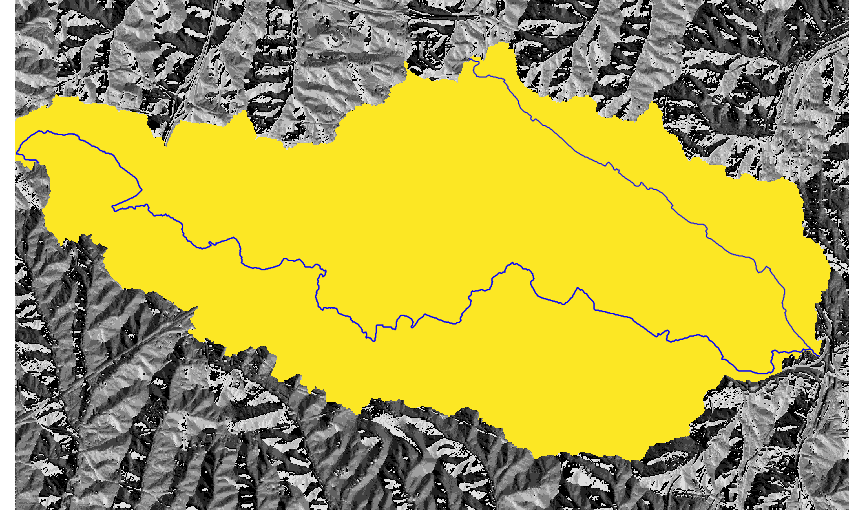
Longest flow path calculation and subwatershed delineation in one run
Calculate longest flow paths and delineate subwatersheds in one run:
# set computational region
g.region -p raster=elevation
# calculate drainage directions using r.watershed
r.watershed -s elevation=elevation drainage=drain_directions
# get nsres
eval `r.info -g map=elevation`
# delineate streams using a threshold
r.accumulate direction=drain_directions threshold=50000 stream=streams
# populate stream lengths
v.db.addtable map=streams
v.to.db map=streams option=length columns=length
# create points along the streams starting from downstream
v.to.points -r input=streams output=stream_points dmax=$nsres
# find outlets (downstream-most less nsres points)
cats=`db.select -c sql="select stream_points_2.cat from stream_points_2 \
inner join stream_points_1 on stream_points_1.cat = stream_points_2.lcat \
where length-along > 0.5*$nsres and length-along < 1.5*$nsres"`
cats=`echo $cats | tr " " ,`
v.extract input=stream_points layer=2 cats=$cats output=stream_outlets
# calculate longest flow paths and delineate subwatersheds for all outlets
r.accumulate direction=drain_directions lfp=lfp id_column=id \
outlet=stream_outlets outlet_layer=2 outlet_id_column=lcat \
subwatershed=subwatersheds
# convert subwatersheds to vector
r.to.vect input=subwatersheds type=area output=subwatersheds
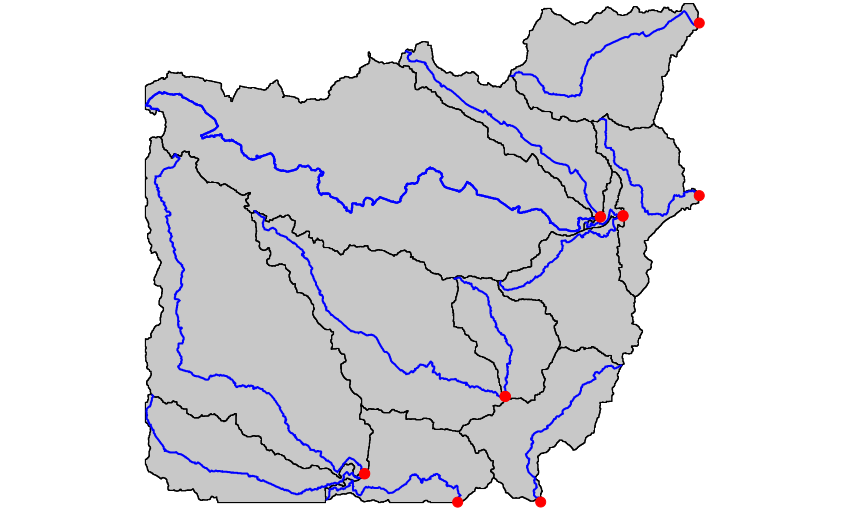
SEE ALSO
r.flowaccumulation, r.watershed, r.stream.extract, r.stream.distanceHow to delineate stream networks in GRASS GIS
How to calculate the longest flow path in GRASS GIS
REFERENCES
Huidae Cho, September 2020. A Recursive Algorithm for Calculating the Longest Flow Path and Its Iterative Implementation. Environmental Modelling & Software 131, 104774. doi:10.1016/j.envsoft.2020.104774.AUTHOR
Huidae ChoSOURCE CODE
Available at: r.accumulate source code (history)
Latest change: Tuesday May 14 17:21:18 2024 in commit: 8135b8a7e919e816997f32f710b53a5af48362ce
Note: This document is for an older version of GRASS GIS that will be discontinued soon. You should upgrade, and read the current manual page.
Main index | Raster index | Topics index | Keywords index | Graphical index | Full index
© 2003-2023 GRASS Development Team, GRASS GIS 8.2.2dev Reference Manual